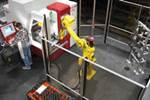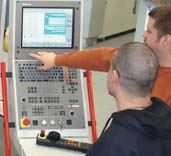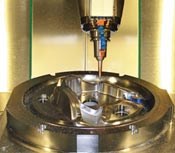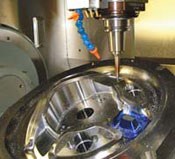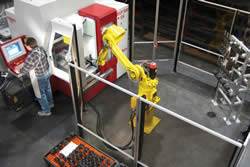Operations Reassessment Yields Customer Diversification, Increased Competitiveness and Improved Capabilities
The recession came early to Michigan shops serving the automotive industry. For Eifel—a company specializing in simultaneous product development and manufacturing with a heavy emphasis on mold manufacturing—it resulted in the acceleration of a strategic plan for growth.
According to Rick Hecker, Eifel Mold & Engineering President and Owner, “Some time ago, we came to the realization that we needed to diversify our customer base to be less dependent on the automotive industry. Also, in order to satisfy our valued automotive customers, we wanted to become more competitive with regard to delivery and to improve our capabilities in the development of complex parts. I put together a team of our key people, and we reassessed our operation in light of new technologies available.”
New Technologies Strategy
Eifel is no stranger to advanced technology. Founded in 1973 by Hecker’s father, Josef, a master pattern and model maker, the company was built on a tradition of starting at the beginning of the product development cycle and maintaining a logical flow through the manufacturing process.
Tim Hay, Eifel’s Mold Designer, explains, “We’re equipped with extensive CAD capability, utilizing UG NX-4 design software for solid modeling and ICEM Surf for freeform design. Delcam PowerMILL® is used to generate the cutter path. Our models are all color-coded to a predetermined standard that we’ve developed and which is understood by everyone from designers through machine operators. As a result, it’s easier for them to set up their own machine and, when necessary, run two or more machines at a time.”
Most of the molds Eifel manufactures involve highly detailed designs for plastic parts. Most are either single or dual cavity in P20 steel with a Rockwell of 30-32, although some applications can require H-13 steel with a 50 to 60 Rockwell.
Gary Schulz, who works on the production side, states, “Thanks to our model shop heritage, our people are involved upfront and contribute to developing realistic solutions that best meet the customer’s needs. Part of our value-added is that by refining the design, we’re frequently able to introduce efficiencies that save cost for the customer and deliver a better product.”
The Search for Improved Manufacturing Technology
The search for improved manufacturing technology led the Eifel team to consider acquiring 5-axis machining capability. Hecker explains, “We saw that 5-axis machining was replacing EDM in many applications. We could see the benefits of using a 5-axis machine on conventional 3- and 4-axis parts in that it would reduce setup time and fixturing costs and produce a better finish. The 5-axis capability also would be useful in toolmaking, as we have to make many of the tools we use.”
The team consulted with Keith Kauzlarich, VP of Single Source Technologies (Auburn Hills, MI), a machinery and ancillary equipment supplier, who explains, “Many of Eifel’s molds have undercuts and involve cutting to zero and negative stock. Rick explained that they wanted to diversify particularly into the defense, aerospace and medical markets, so I immediately thought of Hermle. The heavy-duty trunion design and triple rail geometry are excellent for moldmaking applications, and Hermle’s long experience in 5-axis machining—especially of hard materials—enables them to provide the support someone starting out in 5-axis would need. Also, Hermle is exceptionally well-niched in the markets that Eifel is targeting.”
The machine selected is a Hermle C 40 U, a 5-axis machining center sized for applications in the mid-size part range. Following installation, it was decided to first use the machine only in 3- and 4-axis applications.
Five-Axis Challenging Applications
One of the most challenging projects involves a mold for a highly stylized steering wheel. The wheel will ultimately be made of urethane, which means that Eifel has to use more undercutting. Styling grooves, simulating leather, run around the spokes and the detail is exceptionally fine.
Schulz explains, “Before we had the 5-axis machine, development of this part took from 10 to 12 hours. Every time we needed to undercut, we had to continually re-fixture the part. With the new machine, we’ve cut the time to less than two hours. All the work is accomplished with a single setup right on the table.
“As we begin to integrate 5-axis simultaneous machining into our operation, we will be able to bid on different configurations and open the door to new markets,” notes Schulz.
Kauzlarich explains, “In 5-axis machining, the control is key. Hermle offers Siemens and Heidenhain controls that are especially effective in complex 5-axis operations. As Rick and his team become more involved in defense, aerospace and medical applications, the control will have the capability to handle the parts they are making.”
Future Possibilities
Eifel is optimistic about the future and is positioned to take full advantage of new opportunities. “Even in our automotive business, we are dealing with more global customers including VW, Nissan and Hyundai,” Hecker explains. “In order to qualify ourselves with aerospace and medical customers, we are already certified ISO 9000 and will shortly move up to AS 9100. We’re actively prospecting through word-of-mouth, personal calls, trade shows and the Internet, and we’re keeping current with the latest advances in software. We can’t predict the future, but we can prepare for it.”
Related Content
Making Mentoring Work | MMT Chat Part 2
Three of the TK Mold and Engineering team in Romeo, Michigan join me for Part 2 of this MMT Chat on mentorship by sharing how the AMBA’s Meet a Mentor Program works, lessons learned (and applied) and the way your shop can join this effort.
Read MoreConfronting the Mold Design Talent Drought
Recently, I reposted on LinkedIn the results of an informal survey we conducted, which revealed a shortage of skilled mold designers. It quickly gained a lot of traction. Given the response, I thought I'd summarize the feedback and keep the conversation going.
Read MoreMachine Hammer Peening Automates Mold Polishing
A polishing automation solution eliminates hand work, accelerates milling operations and controls surface geometries.
Read MoreWhat is Driving Mold Lifecycle Management Digitalization?
OEMs are looking to partner with suppliers to share and track data across the supply chain for advanced intervention and process management.
Read MoreRead Next
Equipment Expansion Lands Additional Customers
Adding equipment to the shop floor not only accommodates existing customers, but also can serve as an investment in securing work from new customers.
Read MoreAre You a Moldmaker Considering 3D Printing? Consider the 3D Printing Workshop at NPE2024
Presentations will cover 3D printing for mold tooling, material innovation, product development, bridge production and full-scale, high-volume additive manufacturing.
Read MoreHow to Use Strategic Planning Tools, Data to Manage the Human Side of Business
Q&A with Marion Wells, MMT EAB member and founder of Human Asset Management.
Read More
